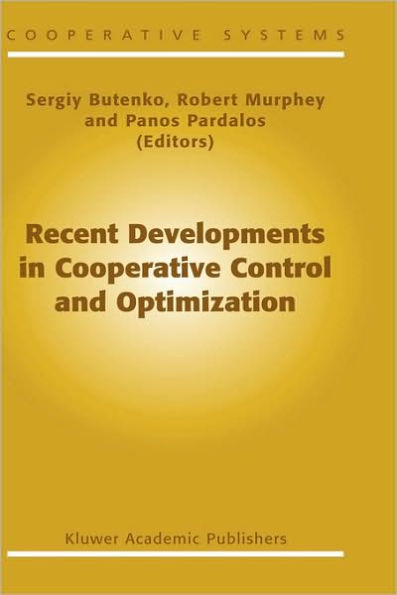Recent Developments in Cooperative Control and Optimization
Over the past several years, cooperative control and optimization has un questionably been established as one of the most important areas of research in the military sciences. Even so, cooperative control and optimization tran scends the military in its scope -having become quite relevant to a broad class of systems with many exciting, commercial, applications. One reason for all the excitement is that research has been so incredibly diverse -spanning many scientific and engineering disciplines. This latest volume in the Cooperative Systems book series clearly illustrates this trend towards diversity and creative thought. And no wonder, cooperative systems are among the hardest systems control science has endeavored to study, hence creative approaches to model ing, analysis, and synthesis are a must! The definition of cooperation itself is a slippery issue. As you will see in this and previous volumes, cooperation has been cast into many different roles and therefore has assumed many diverse meanings. Perhaps the most we can say which unites these disparate concepts is that cooperation (1) requires more than one entity, (2) the entities must have some dynamic behavior that influences the decision space, (3) the entities share at least one common objective, and (4) entities are able to share information about themselves and their environment. Optimization and control have long been active fields of research in engi neering.
1101307342
Recent Developments in Cooperative Control and Optimization
Over the past several years, cooperative control and optimization has un questionably been established as one of the most important areas of research in the military sciences. Even so, cooperative control and optimization tran scends the military in its scope -having become quite relevant to a broad class of systems with many exciting, commercial, applications. One reason for all the excitement is that research has been so incredibly diverse -spanning many scientific and engineering disciplines. This latest volume in the Cooperative Systems book series clearly illustrates this trend towards diversity and creative thought. And no wonder, cooperative systems are among the hardest systems control science has endeavored to study, hence creative approaches to model ing, analysis, and synthesis are a must! The definition of cooperation itself is a slippery issue. As you will see in this and previous volumes, cooperation has been cast into many different roles and therefore has assumed many diverse meanings. Perhaps the most we can say which unites these disparate concepts is that cooperation (1) requires more than one entity, (2) the entities must have some dynamic behavior that influences the decision space, (3) the entities share at least one common objective, and (4) entities are able to share information about themselves and their environment. Optimization and control have long been active fields of research in engi neering.
109.99
In Stock
5
1

Recent Developments in Cooperative Control and Optimization
458
Recent Developments in Cooperative Control and Optimization
458Hardcover(2004)
$109.99
109.99
In Stock

Product Details
| ISBN-13: | 9781402076442 |
|---|---|
| Publisher: | Springer US |
| Publication date: | 12/31/2003 |
| Series: | Cooperative Systems , #3 |
| Edition description: | 2004 |
| Pages: | 458 |
| Product dimensions: | 6.10(w) x 9.25(h) x 0.04(d) |
From the B&N Reads Blog
